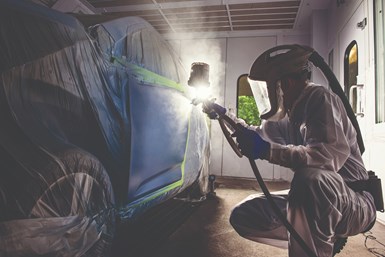
Q. What are the best practices to achieve a flawless liquid coating finish?
Achieving a flawless liquid coating finish isn’t as elusive as one may think. It takes the right practices and equipment within every stage of the spray application process.
Step 1: The Prep Stage
Many shops focus most of their attention on the actual painting and refinishing process, completely overlooking setup and prep. Surface preparation and dust containment is a crucial step before painting (and achieving a flawless finish).
Prepping for a coating includes sanding down the part before it can take paint and removing contaminants from the surface to be painted. Often, surface preparation leads to dust being generated. If this dust is not contained, it can be spread throughout the facility and settle on surfaces that were previously ready to paint — this is where prep stations come in to use.
A prep station, or a curtained work area, is a closed environment designed specifically for prepping and sanding. Inside, temperature and airflow can be controlled to avoid dust and other debris from entering the facility. The prep station’s location within a shop, in conjunction with the paint booth, also plays an important role. A smooth transition to the clean spray booth is necessary so the parts or vehicles remain contaminate-free.
Step 2: The Painting Stage
Before moving the part from the prep station to the cabin, getting the paint booth ready for painting is critical. A poorly trained painter will turn the booth on, get the part inside, and start spraying. However, for an optimal finish, let the booth run first for a few minutes to purge contaminants and settle any dust lingering in the air. A painter should also always wear a clean paint suit and practice good hygiene.
Once the part is safely inside the paint booth, give it a good wipe down with a tack cloth. Ensuring the surface is as clean as possible will help with a seamless painting application. Before beginning to spray, position the part inside the booth correctly within the spray zone. While spraying, releasing the trigger of the spray gun on time is crucial. Without good spraying mechanics, additional overspray can land onto unintended objects or areas. To achieve an even application, avoid overloading the paint or having light spots in any particular area.
Step 3: Post-Painting
After finishing a spray application, the part should remain inside the cabin until the coating is dry. Moving the part too soon can risk dust and debris sticking to the surface. As a general principle, for every 15° over 70°F (which is the substrate temperature, or the baseline for drying), coatings will dry in roughly half the time.
Once the item is removed from the cabin, leave the booth on while preparing to load the next part. This ensures any contaminants have been removed from the booth before the spraying process begins again.
Follow Routine Paint Booth Maintenance
Without routine maintenance, pressure and airflow issues are more likely to occur, as well as contamination caused by overspray. Keeping the booth clean, running right and performing at maximum potential will ensure a clean environment for spray applications.
Cleaning the booth inside and out, including internal mechanics such as filters and air makeup units, should be done daily or weekly. If the booth can’t breathe right, and the draft is being affected, achieving a flawless liquid coating finish will be challenging. The worst thing a facility can do is let the shop run until the booth breaks by not keeping up with routine maintenance, resulting in inadequate paint jobs.
Related Content
Shedding Light on Surface Inspection
State-of-the-art reflector-based lighting system improves luminosity and ergonomics for surface inspection tasks while reducing energy usage.
Read MoreConcrete Reinforced Bars Built to Last
Not all corrosion-resistant materials for infrastructure are created equally. Epoxy-coated steel rebar has advantages that other materials used to prevent corrosion do not.
Read MoreCobot Enters Paint Industry With Safety at the Forefront
This collaborative robot is the first explosion-proof solution for the powder coating and paint arena that meets the U.S.’ stringent safety requirements. Its lead-through teach programming and tablet control are especially appealing to small shops with little proficiency in robotics.
Read MoreSurface Prep Solution for Rusted Rebar in Concrete
Julie Holmquist of Cortec Corporation discusses passivating corrosion on rebar and other reinforcing metals.
Read MoreRead Next
Understanding Paint Atomization
BASF coatings development expert Tim December explains how paint atomization works for both pneumatic spray applicators and high-speed rotary bell applicators.
Read MoreMitigating Water Condensation
Mike Bonner of Saint Clair Systems discusses how to avoid paint defects caused by condensation resulting from compressed air used for atomizers.
Read More











.jpg;maxWidth=300;quality=90)








